Macroeconomics Assignment, Semester 2, 2019, University Name
VerifiedAdded on 2022/10/10
|9
|1724
|115
Homework Assignment
AI Summary
This macroeconomics assignment addresses several key concepts. It begins by differentiating between risk and uncertainty, interest and exchange rates, and supply-side versus demand-side shocks, as well as trade deficits and net foreign debt. The assignment then delves into measuring inflation, unemployment, and economic growth in Australia, along with the current cash rate and exchange rate. An AD-AS model is used to analyze the effects of a fall in aggregate demand, contrasting the classical and Keynesian economic perspectives. The influence of consumption demand, investment demand, and net exports on aggregate demand are also considered, alongside factors impacting aggregate supply. Finally, the importance of quarterly GDP movements is discussed, particularly concerning recession, and the potential responses through fiscal and monetary policies. The assignment uses diagrams and references various economic literature to support its analysis.

Running head: Macroeconomics
Macroeconomics
Name of the Student
Name of the University
Student ID
Macroeconomics
Name of the Student
Name of the University
Student ID
Paraphrase This Document
Need a fresh take? Get an instant paraphrase of this document with our AI Paraphraser
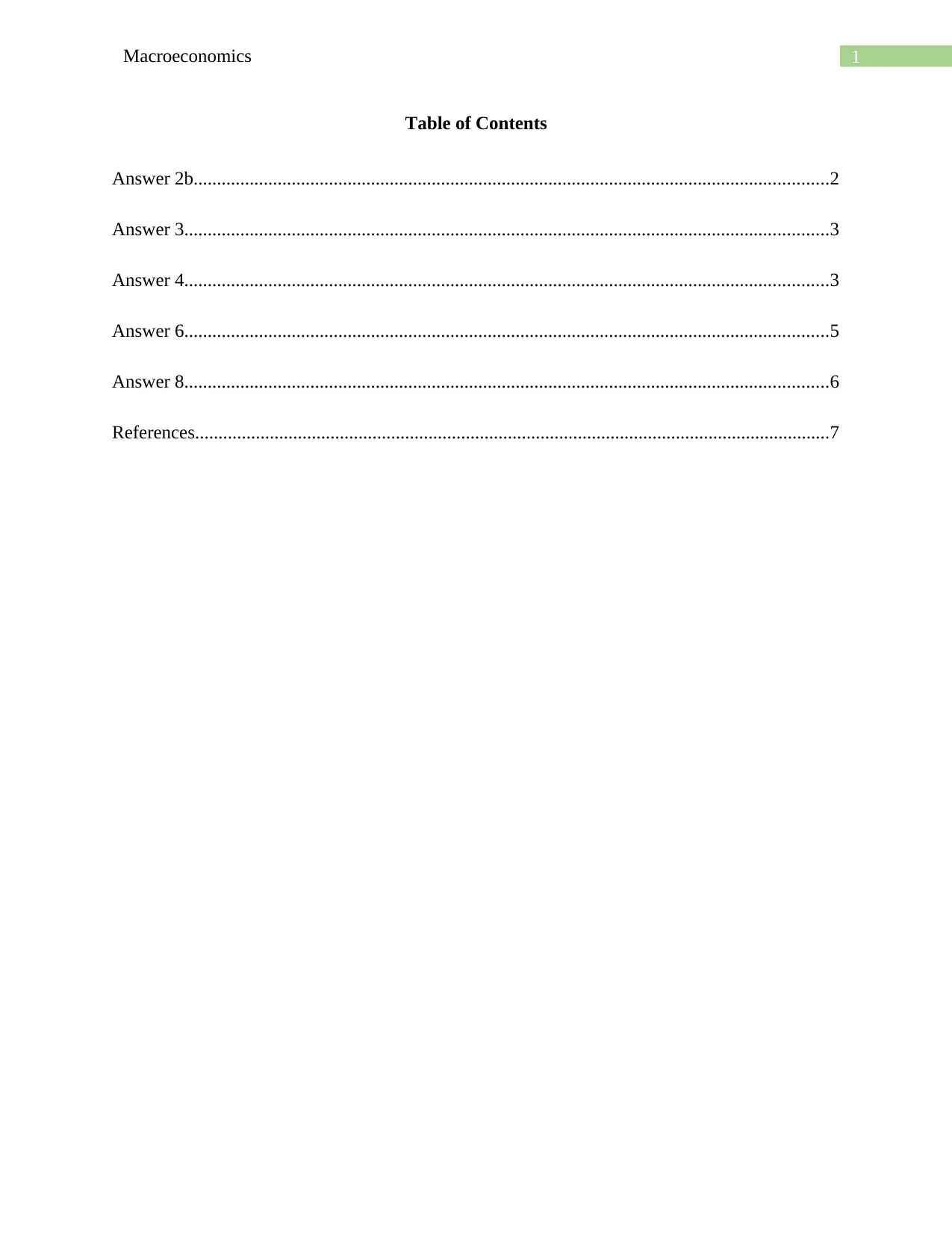
1Macroeconomics
Table of Contents
Answer 2b........................................................................................................................................2
Answer 3..........................................................................................................................................3
Answer 4..........................................................................................................................................3
Answer 6..........................................................................................................................................5
Answer 8..........................................................................................................................................6
References........................................................................................................................................7
Table of Contents
Answer 2b........................................................................................................................................2
Answer 3..........................................................................................................................................3
Answer 4..........................................................................................................................................3
Answer 6..........................................................................................................................................5
Answer 8..........................................................................................................................................6
References........................................................................................................................................7

2Macroeconomics
Answer 2b
Uncertainty is an economic phenomena that cannot be predicted and thus it is
uncontrollable. On the other hand, risk is the phenomena outcome which can be predicted and
can be avoided as it is controllable (Halpern, 2017). Apart from that, risk is quantifiable as the
outcome is known and uncertainty is not as outcome is unknown.
Interest rate is the amount at which investment gets its return given a specified time
period whereas exchange rate is the value of money one get by exchanging one currency with
another (Cairns, 2018). Additionally exchange rate changes with the change in interest rate and
both share a positive relationship. Interest rate is the cause and exchange rate is the effect.
Supply side shock is the shock that occurs to an economy due to supply side factors such
as change in labour force, fall in supply of crude oil and factors of production (Hurst, 2015). It
depends on the supply side performer of an economy. Alternatively, demand side shock is the
shock that occurs to an economy due to increase in consumption demand and it solely depends
on the behaviour of the consumer (Kang, Gracia & Ratti, 2017). Supply side shock causes cost
push inflation and demand side shock causes demand pull inflation.
Trade deficit occurs when a country participates in international trade market and spends
more in imports than its export (Baker, 2018). However, in the case of net foreign debt it does
not involve in any kind of trade with any country but takes loan from other countries for
development. Thus, if the loans taken by a country is not repaid in then net foreign debt
increases, however, this is not the case with trade deficit as it deals in goods and services.
Answer 2b
Uncertainty is an economic phenomena that cannot be predicted and thus it is
uncontrollable. On the other hand, risk is the phenomena outcome which can be predicted and
can be avoided as it is controllable (Halpern, 2017). Apart from that, risk is quantifiable as the
outcome is known and uncertainty is not as outcome is unknown.
Interest rate is the amount at which investment gets its return given a specified time
period whereas exchange rate is the value of money one get by exchanging one currency with
another (Cairns, 2018). Additionally exchange rate changes with the change in interest rate and
both share a positive relationship. Interest rate is the cause and exchange rate is the effect.
Supply side shock is the shock that occurs to an economy due to supply side factors such
as change in labour force, fall in supply of crude oil and factors of production (Hurst, 2015). It
depends on the supply side performer of an economy. Alternatively, demand side shock is the
shock that occurs to an economy due to increase in consumption demand and it solely depends
on the behaviour of the consumer (Kang, Gracia & Ratti, 2017). Supply side shock causes cost
push inflation and demand side shock causes demand pull inflation.
Trade deficit occurs when a country participates in international trade market and spends
more in imports than its export (Baker, 2018). However, in the case of net foreign debt it does
not involve in any kind of trade with any country but takes loan from other countries for
development. Thus, if the loans taken by a country is not repaid in then net foreign debt
increases, however, this is not the case with trade deficit as it deals in goods and services.
⊘ This is a preview!⊘
Do you want full access?
Subscribe today to unlock all pages.

Trusted by 1+ million students worldwide

3Macroeconomics
Answer 3
Inflation is an economic phenomenon that occurs due to increase in price of goods and
services available or produced in an economy. It is generally measured on the basis of consumer
price index or whole price index (Bernanke et al., 2018). In Australia inflation is measured based
on consumer price index and thus the current level of inflation rate in the country is 1.6%.
Unemployment is the economic condition where people willing to work could not get any
job due to various situation and leads to joblessness. It is of various kind but most persisting are
structural, frictional and cyclical unemployment. The current level of unemployment in Australia
is 5.1%.
Economic growth rate is the measure of annual increase in gross domestic product of a
country. The current level of economic growth rate in Australia is 2.75%
The bank rate in Australia is known as cash rate and it’s the rate at which Reserve Bank
of Australia changes. It is used to control money by using cash rate to expand or contract the
economy. The current level cash rate in the country is 1%
Exchange is the trade-off between two currencies at a time. .Exchange rate differs with
the different types of currencies (Gabaiz& Maggiori, 2015). In Australia, the current level of
exchange rate between Australian dollar and the United States dollar is given as 0.6762.
Answer 4
Fall in aggregate demand of an economy shifts the aggregate demand to the left from AD
to AD1 as shown in the figure in the figure below. Due to this fall in demand the price level and
real GDP of the economy got impacted (Leduc & Liu 2016). The price level declined from P* to
P1 and the real GDP declined from Q* to Q1. However, this fall in demand, price and real GDP
Answer 3
Inflation is an economic phenomenon that occurs due to increase in price of goods and
services available or produced in an economy. It is generally measured on the basis of consumer
price index or whole price index (Bernanke et al., 2018). In Australia inflation is measured based
on consumer price index and thus the current level of inflation rate in the country is 1.6%.
Unemployment is the economic condition where people willing to work could not get any
job due to various situation and leads to joblessness. It is of various kind but most persisting are
structural, frictional and cyclical unemployment. The current level of unemployment in Australia
is 5.1%.
Economic growth rate is the measure of annual increase in gross domestic product of a
country. The current level of economic growth rate in Australia is 2.75%
The bank rate in Australia is known as cash rate and it’s the rate at which Reserve Bank
of Australia changes. It is used to control money by using cash rate to expand or contract the
economy. The current level cash rate in the country is 1%
Exchange is the trade-off between two currencies at a time. .Exchange rate differs with
the different types of currencies (Gabaiz& Maggiori, 2015). In Australia, the current level of
exchange rate between Australian dollar and the United States dollar is given as 0.6762.
Answer 4
Fall in aggregate demand of an economy shifts the aggregate demand to the left from AD
to AD1 as shown in the figure in the figure below. Due to this fall in demand the price level and
real GDP of the economy got impacted (Leduc & Liu 2016). The price level declined from P* to
P1 and the real GDP declined from Q* to Q1. However, this fall in demand, price and real GDP
Paraphrase This Document
Need a fresh take? Get an instant paraphrase of this document with our AI Paraphraser
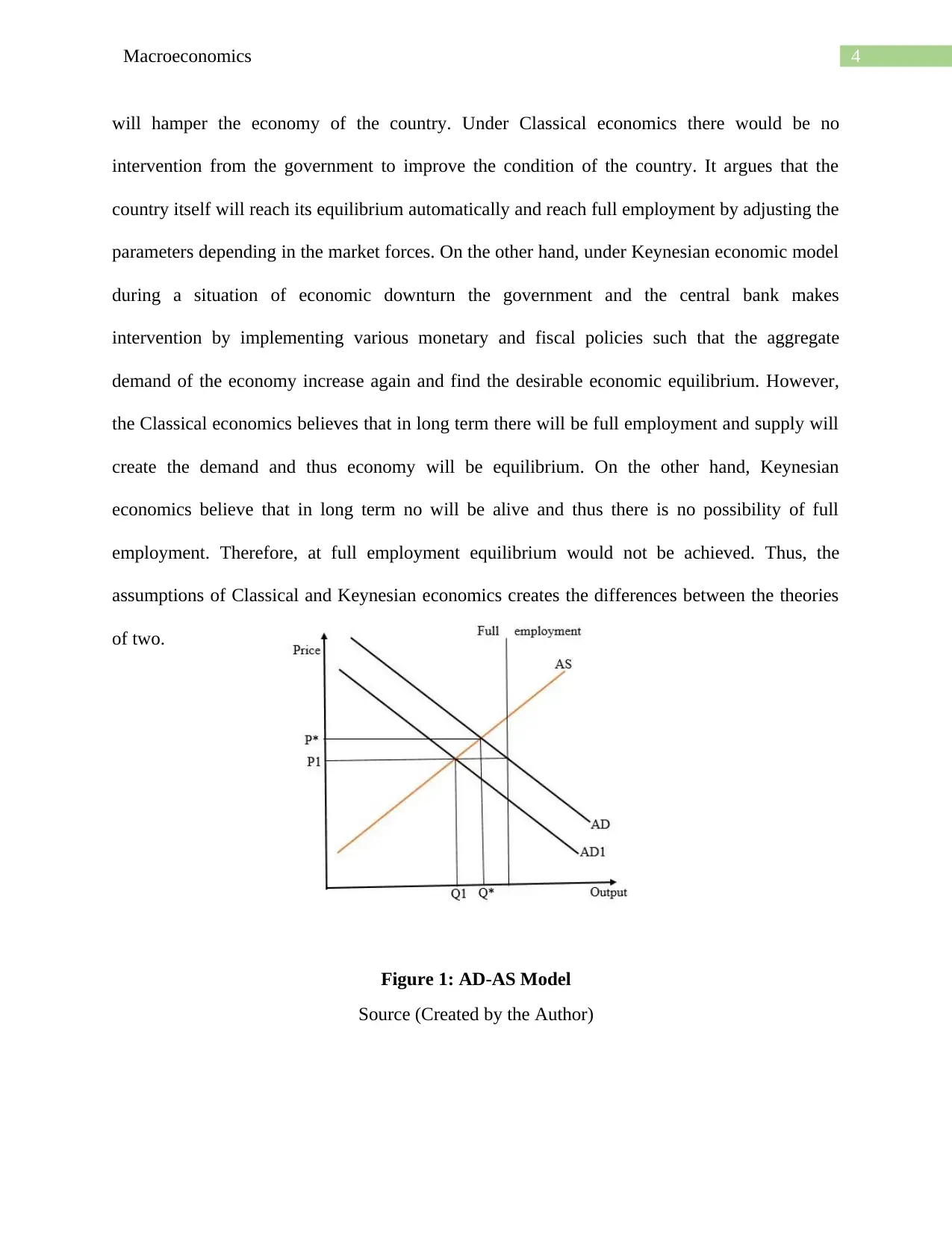
4Macroeconomics
will hamper the economy of the country. Under Classical economics there would be no
intervention from the government to improve the condition of the country. It argues that the
country itself will reach its equilibrium automatically and reach full employment by adjusting the
parameters depending in the market forces. On the other hand, under Keynesian economic model
during a situation of economic downturn the government and the central bank makes
intervention by implementing various monetary and fiscal policies such that the aggregate
demand of the economy increase again and find the desirable economic equilibrium. However,
the Classical economics believes that in long term there will be full employment and supply will
create the demand and thus economy will be equilibrium. On the other hand, Keynesian
economics believe that in long term no will be alive and thus there is no possibility of full
employment. Therefore, at full employment equilibrium would not be achieved. Thus, the
assumptions of Classical and Keynesian economics creates the differences between the theories
of two.
Figure 1: AD-AS Model
Source (Created by the Author)
will hamper the economy of the country. Under Classical economics there would be no
intervention from the government to improve the condition of the country. It argues that the
country itself will reach its equilibrium automatically and reach full employment by adjusting the
parameters depending in the market forces. On the other hand, under Keynesian economic model
during a situation of economic downturn the government and the central bank makes
intervention by implementing various monetary and fiscal policies such that the aggregate
demand of the economy increase again and find the desirable economic equilibrium. However,
the Classical economics believes that in long term there will be full employment and supply will
create the demand and thus economy will be equilibrium. On the other hand, Keynesian
economics believe that in long term no will be alive and thus there is no possibility of full
employment. Therefore, at full employment equilibrium would not be achieved. Thus, the
assumptions of Classical and Keynesian economics creates the differences between the theories
of two.
Figure 1: AD-AS Model
Source (Created by the Author)
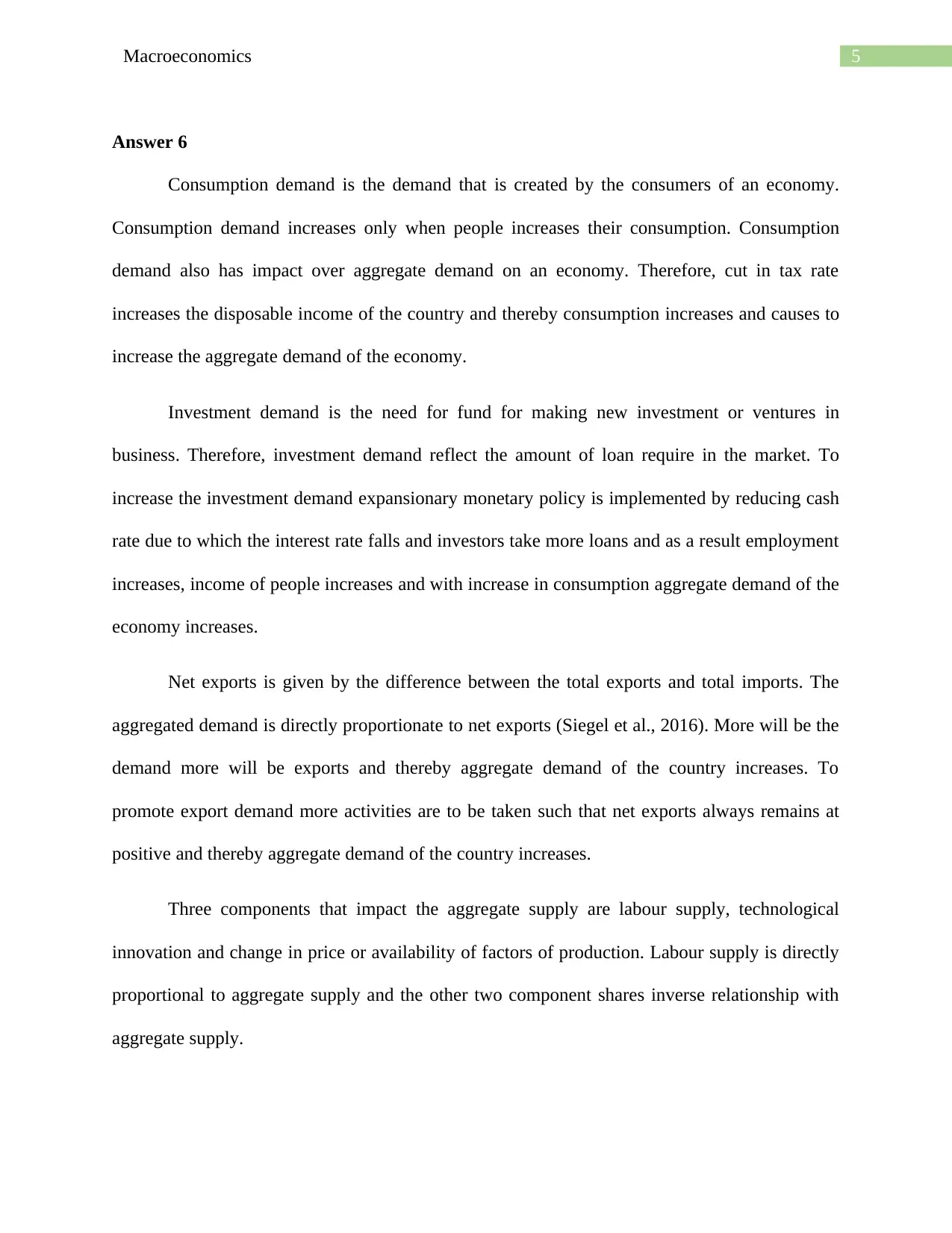
5Macroeconomics
Answer 6
Consumption demand is the demand that is created by the consumers of an economy.
Consumption demand increases only when people increases their consumption. Consumption
demand also has impact over aggregate demand on an economy. Therefore, cut in tax rate
increases the disposable income of the country and thereby consumption increases and causes to
increase the aggregate demand of the economy.
Investment demand is the need for fund for making new investment or ventures in
business. Therefore, investment demand reflect the amount of loan require in the market. To
increase the investment demand expansionary monetary policy is implemented by reducing cash
rate due to which the interest rate falls and investors take more loans and as a result employment
increases, income of people increases and with increase in consumption aggregate demand of the
economy increases.
Net exports is given by the difference between the total exports and total imports. The
aggregated demand is directly proportionate to net exports (Siegel et al., 2016). More will be the
demand more will be exports and thereby aggregate demand of the country increases. To
promote export demand more activities are to be taken such that net exports always remains at
positive and thereby aggregate demand of the country increases.
Three components that impact the aggregate supply are labour supply, technological
innovation and change in price or availability of factors of production. Labour supply is directly
proportional to aggregate supply and the other two component shares inverse relationship with
aggregate supply.
Answer 6
Consumption demand is the demand that is created by the consumers of an economy.
Consumption demand increases only when people increases their consumption. Consumption
demand also has impact over aggregate demand on an economy. Therefore, cut in tax rate
increases the disposable income of the country and thereby consumption increases and causes to
increase the aggregate demand of the economy.
Investment demand is the need for fund for making new investment or ventures in
business. Therefore, investment demand reflect the amount of loan require in the market. To
increase the investment demand expansionary monetary policy is implemented by reducing cash
rate due to which the interest rate falls and investors take more loans and as a result employment
increases, income of people increases and with increase in consumption aggregate demand of the
economy increases.
Net exports is given by the difference between the total exports and total imports. The
aggregated demand is directly proportionate to net exports (Siegel et al., 2016). More will be the
demand more will be exports and thereby aggregate demand of the country increases. To
promote export demand more activities are to be taken such that net exports always remains at
positive and thereby aggregate demand of the country increases.
Three components that impact the aggregate supply are labour supply, technological
innovation and change in price or availability of factors of production. Labour supply is directly
proportional to aggregate supply and the other two component shares inverse relationship with
aggregate supply.
⊘ This is a preview!⊘
Do you want full access?
Subscribe today to unlock all pages.

Trusted by 1+ million students worldwide

6Macroeconomics
Answer 8
The quarterly movements of GDP are important because it provides the information
about the condition of an economy in the short run and thus by assessing the quarterly
movements of the GDP it can be predicted that in which way the economy is approaching.
Therefore, by perceiving any ill changes in the economy the government can take necessary
steps to mitigate the effect of the adverse conditions. Now, if a country faces two successive
quarters of negative economic growth then the country will go into recession (Eaton et al., 2016).
However, it is better to prevent recession than to cure it. A country always starts to slow down
economically before entering recession period, thus perceiving the symptoms the government
and the central bank can implement expansionary fiscal and expansionary monetary policy
respectively. The expansionary policies whether it is fiscal or monetary increases the money
supply of an economy and thereby the disposable income of individuals of the economy
increases. Therefore, with increased income the propensity to consume increases and
consumption demand increases as a result. Further, the aggregate demand increases and the price
level of the economy increases. This rise in price level increases the inflation of the economy and
thereby it prevents the economy from going into recession.
Answer 8
The quarterly movements of GDP are important because it provides the information
about the condition of an economy in the short run and thus by assessing the quarterly
movements of the GDP it can be predicted that in which way the economy is approaching.
Therefore, by perceiving any ill changes in the economy the government can take necessary
steps to mitigate the effect of the adverse conditions. Now, if a country faces two successive
quarters of negative economic growth then the country will go into recession (Eaton et al., 2016).
However, it is better to prevent recession than to cure it. A country always starts to slow down
economically before entering recession period, thus perceiving the symptoms the government
and the central bank can implement expansionary fiscal and expansionary monetary policy
respectively. The expansionary policies whether it is fiscal or monetary increases the money
supply of an economy and thereby the disposable income of individuals of the economy
increases. Therefore, with increased income the propensity to consume increases and
consumption demand increases as a result. Further, the aggregate demand increases and the price
level of the economy increases. This rise in price level increases the inflation of the economy and
thereby it prevents the economy from going into recession.
Paraphrase This Document
Need a fresh take? Get an instant paraphrase of this document with our AI Paraphraser
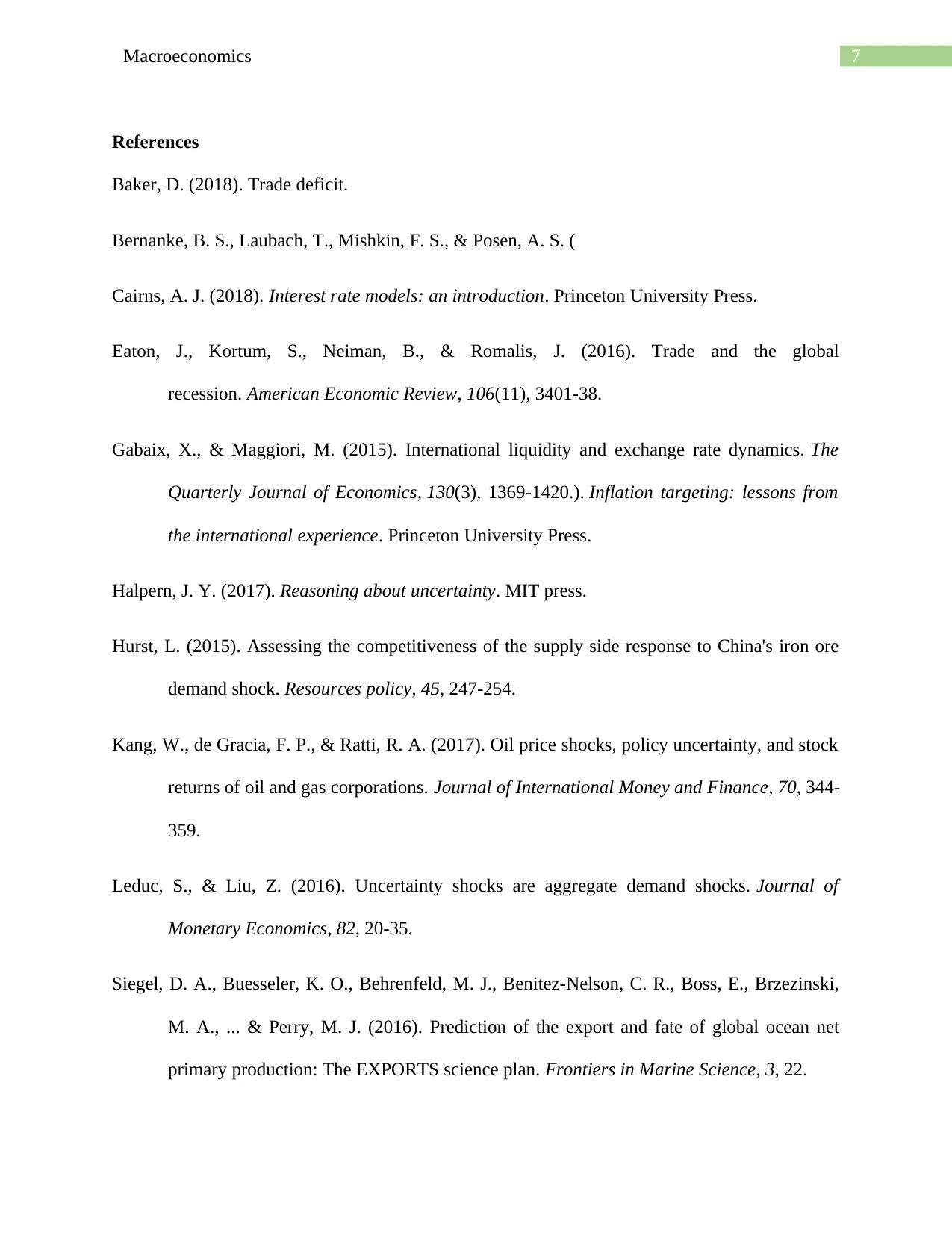
7Macroeconomics
References
Baker, D. (2018). Trade deficit.
Bernanke, B. S., Laubach, T., Mishkin, F. S., & Posen, A. S. (
Cairns, A. J. (2018). Interest rate models: an introduction. Princeton University Press.
Eaton, J., Kortum, S., Neiman, B., & Romalis, J. (2016). Trade and the global
recession. American Economic Review, 106(11), 3401-38.
Gabaix, X., & Maggiori, M. (2015). International liquidity and exchange rate dynamics. The
Quarterly Journal of Economics, 130(3), 1369-1420.). Inflation targeting: lessons from
the international experience. Princeton University Press.
Halpern, J. Y. (2017). Reasoning about uncertainty. MIT press.
Hurst, L. (2015). Assessing the competitiveness of the supply side response to China's iron ore
demand shock. Resources policy, 45, 247-254.
Kang, W., de Gracia, F. P., & Ratti, R. A. (2017). Oil price shocks, policy uncertainty, and stock
returns of oil and gas corporations. Journal of International Money and Finance, 70, 344-
359.
Leduc, S., & Liu, Z. (2016). Uncertainty shocks are aggregate demand shocks. Journal of
Monetary Economics, 82, 20-35.
Siegel, D. A., Buesseler, K. O., Behrenfeld, M. J., Benitez-Nelson, C. R., Boss, E., Brzezinski,
M. A., ... & Perry, M. J. (2016). Prediction of the export and fate of global ocean net
primary production: The EXPORTS science plan. Frontiers in Marine Science, 3, 22.
References
Baker, D. (2018). Trade deficit.
Bernanke, B. S., Laubach, T., Mishkin, F. S., & Posen, A. S. (
Cairns, A. J. (2018). Interest rate models: an introduction. Princeton University Press.
Eaton, J., Kortum, S., Neiman, B., & Romalis, J. (2016). Trade and the global
recession. American Economic Review, 106(11), 3401-38.
Gabaix, X., & Maggiori, M. (2015). International liquidity and exchange rate dynamics. The
Quarterly Journal of Economics, 130(3), 1369-1420.). Inflation targeting: lessons from
the international experience. Princeton University Press.
Halpern, J. Y. (2017). Reasoning about uncertainty. MIT press.
Hurst, L. (2015). Assessing the competitiveness of the supply side response to China's iron ore
demand shock. Resources policy, 45, 247-254.
Kang, W., de Gracia, F. P., & Ratti, R. A. (2017). Oil price shocks, policy uncertainty, and stock
returns of oil and gas corporations. Journal of International Money and Finance, 70, 344-
359.
Leduc, S., & Liu, Z. (2016). Uncertainty shocks are aggregate demand shocks. Journal of
Monetary Economics, 82, 20-35.
Siegel, D. A., Buesseler, K. O., Behrenfeld, M. J., Benitez-Nelson, C. R., Boss, E., Brzezinski,
M. A., ... & Perry, M. J. (2016). Prediction of the export and fate of global ocean net
primary production: The EXPORTS science plan. Frontiers in Marine Science, 3, 22.
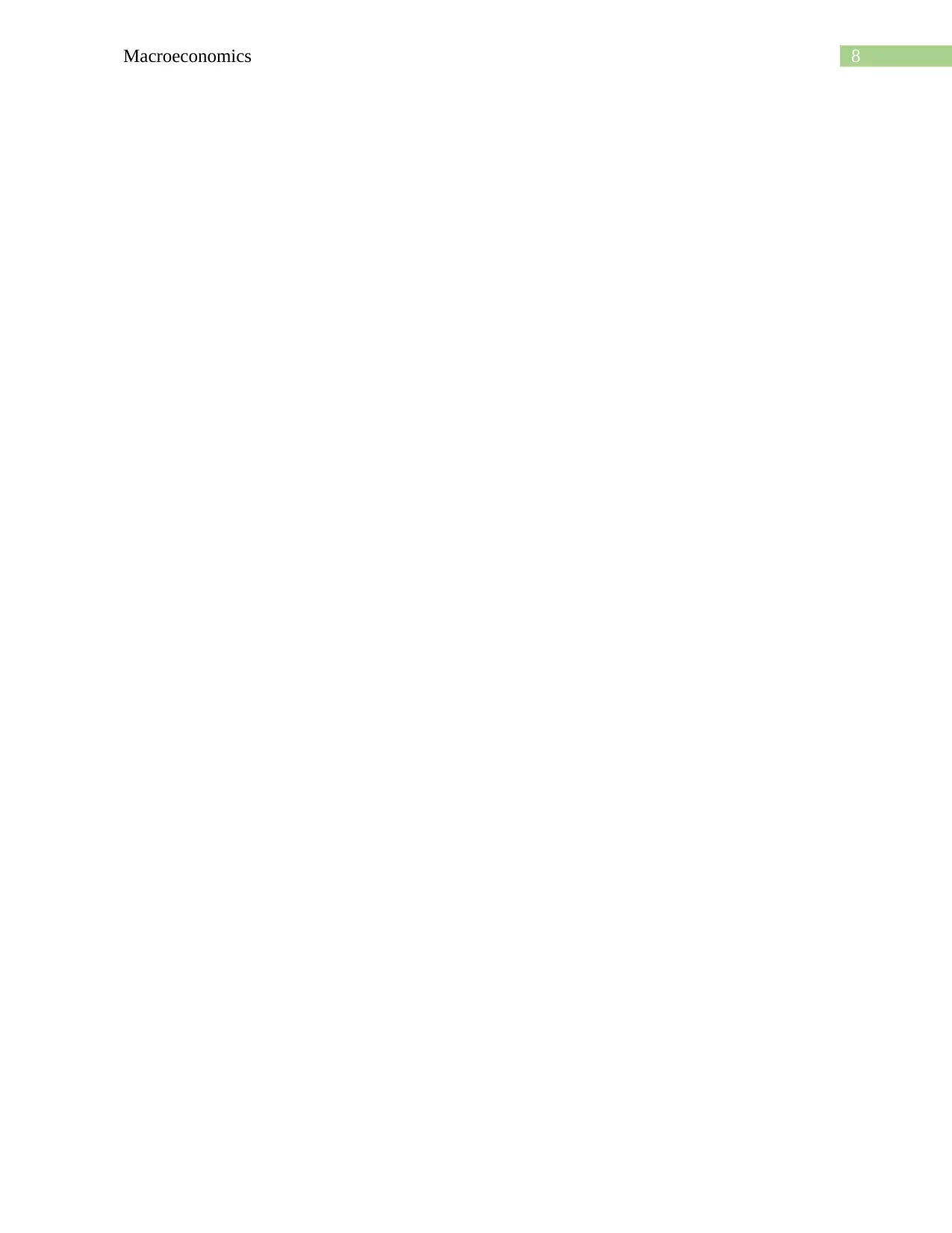
8Macroeconomics
⊘ This is a preview!⊘
Do you want full access?
Subscribe today to unlock all pages.

Trusted by 1+ million students worldwide
1 out of 9
Related Documents
Your All-in-One AI-Powered Toolkit for Academic Success.
+13062052269
info@desklib.com
Available 24*7 on WhatsApp / Email
![[object Object]](/_next/static/media/star-bottom.7253800d.svg)
Unlock your academic potential
Copyright © 2020–2025 A2Z Services. All Rights Reserved. Developed and managed by ZUCOL.





